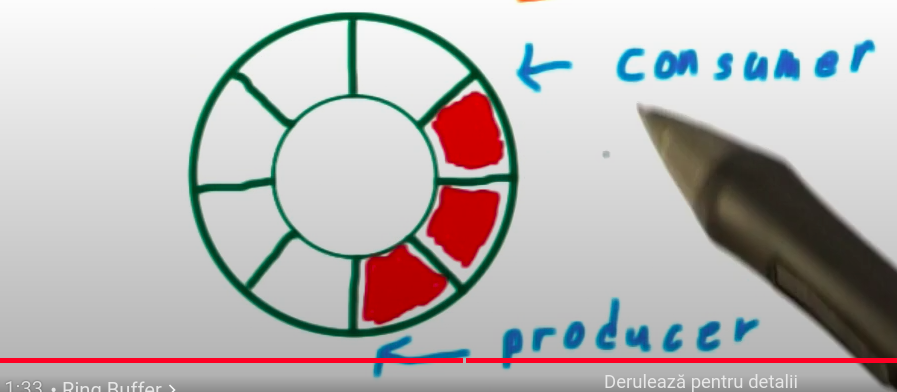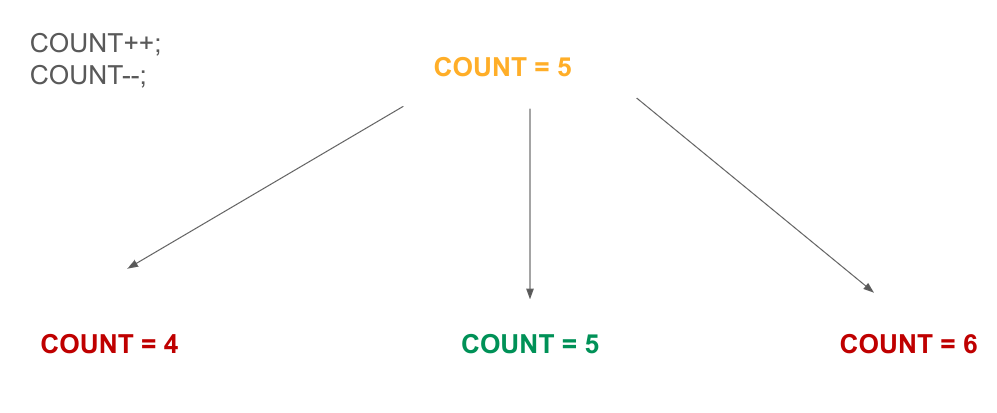Process Synchronization Background
A system typically consists of several (perhaps hundreds or even thousands) of threads running either concurrently or in parallel. As we saw in the last chapter about threads, they share user data.
When the shared data is not controlled, corrupt data values may appear, this phenomenon being called a race condition.
Producer-Consumer problem
Do you remember what a cooperating process was?
If not, see last week's chapter.
To illustrate the concept of cooperating processes, let's consider the producer-consumer problem, a common paradigm for cooperating processes.
A producer process produces information that is consumed by a consumer process.
One solution to this problem involves shared memory, a concept introduced in the last chapter, as well. To allow both producer and consumer processes to run concurrently, we must have a viable buffer of items that can be filled by the producer and emptied by the consumer.
The buffer will be the region of memory that will be shared.
We want the producer and consumer to be synchronized so that the consumer does not try to consume an item that has not yet been produced!
Shared memory approach
- Let's define our bounded buffer (in this case the consumer must wait if the buffer is empty, and the producer must wait if the buffer is full), our item and the variables
inandout.
// fixed buffer size
#define BUFFER_SIZE 10
// we define our item
typedef struct {
// ...
} item;
// circular array with 2 logical pointers, in and out
item buffer[BUFFER_SIZE];
// in points to the next free position in the buffer
int in = 0;
// out points to the first full position of the buffer
int out = 0;
The buffer is empty when in == out.
The buffer is full when ((in + 1) % BUFFER_SIZE) == out.
- Now let's implement the producer:
item next_produced;
while(true) {
/* produce an item in next_produced */
// if the buffer is full, do nothing
while( ((in + 1) % BUFFER_SIZE) == out)
;
// otherwise, add the produced item in the buffer
buffer[in] = next_produced;
// calculate the next "pointer" to the free position
in = (in + 1) % BUFFER_SIZE;
}
- The consumer, as well:
item next_consumed;
while(true) {
// if the buffer is empty, do nothing
while (in == out)
;
// select the item to consume
next_consumed = buffer[out];
// calculate the next "pointer" to the full position
out = (out + 1) % BUFFER_SIZE;
/* consume the item in next_consumed */
}
The buffer is circular, with in and out "chasing" each other. Watch this excellent short video for more.

Do you think this illustration is fully correct?
How many items can we have at most in our buffer?
Although the code above is correct, we have a little setback. Only BUFFER_SIZE-1 elements are allowed in the buffer (take a pen and paper and see it for youself)!
Adding count
To solve this, we can add a variable count = 0;
We'll increment, count++, when adding a new item to the buffer and decrement, count--, when removing one item from the buffer.
- New Producer
item next_produced;
while(true) {
/* produce an item in next_produced */
// if the buffer is full, do nothing
while( count == BUFFER_SIZE )
;
// otherwise, add the produced item in the buffer
buffer[in] = next_produced;
// calculate the next "pointer" to the free position
in = (in + 1) % BUFFER_SIZE;
count++;
}
- New Consumer
item next_consumed;
while(true) {
// if the buffer is empty, do nothing
while (count == 0)
;
// select the item to consume
next_consumed = buffer[out];
// calculate the next "pointer" to the full position
out = (out + 1) % BUFFER_SIZE;
count--;
/* consume the item in next_consumed */
}
Super, now everything makes even more sense and we have BUFFER_SIZE items as we wanted! Surely, we solved this problem, right?

Well, not really, because this raises even bigger issues!
Although the producer and consumer routines shown above are correct separately, they may not function correctly when executed concurrently!
To observe this claim, let's take the following case: imagine count = 5 and 2 operations are next, count++ and then count--. Of course, the correct and final answer after the 2 statements are executed should be count=5, however that's not the case! In reality, we can have 3 outputs, namely count=4, count=5 and count=6! 🤯

Understanding the paradox
As mindblowing as this is, we can show that the value of count may be incorrect by reminding ourselves how operations are implemented in machine language.
register1 = count
register1 = register1 + 1
count = register1
register2 = count
register2 = register2 - 1
count = register2
The concurrent execution of count++ and count-- is equivalent to a sequential execution in which the lower-level statements presented previously are interleaved in some arbitrary order (but the order within each high-level statement is preserved). One such interleaving is the following:

We would arrive at this incorrect state because we allowed both processes to manipulate the variable count concurrently!
A situation like this, where several processes access and manipulate the same data concurrently and the outcome of the execution depends on the particular order in which the access takes place, is called a race condition.